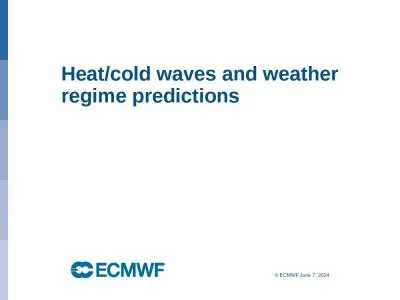

EuroAtlantic circulation regimes predictions 2 We are evaluating the predictive skill of the EA regimes using the S2S data base In particular we are interested in assessing the regime transitions ID: 911227
Download Presentation The PPT/PDF document "Heat/cold waves and weather regime predi..." is the property of its rightful owner. Permission is granted to download and print the materials on this web site for personal, non-commercial use only, and to display it on your personal computer provided you do not modify the materials and that you retain all copyright notices contained in the materials. By downloading content from our website, you accept the terms of this agreement.
Slide1
Heat/cold waves and weather regime predictions
Slide2Euro-Atlantic circulation regimes predictions:
2
We are evaluating the predictive skill of the EA regimes using the S2S data base.
In particular we are interested in assessing the regime transitions (
climatolgical
frequencies, loss of skill, physical processes associated with it)
We have been looking at the re-forecast data for a number of S2S models in the cold season.
NAO- and BL are the flow patterns strongly associated with high impact temperature anomalies.
Slide3Regimes based on clustering of daily anomalies for 29 cold seasons (1980-2008)
3
‘k means’ clustering applied to EOF pre-filtered data (retaining 80% of variance)
Obtain well-
known
Euro-Atlantic regime patterns
m
2
s
2
500 hPa geopotential
Slide4Predicting skill associated with the Euro-Atlantic Regimes:
4
NAO +
NAO -
Blocking
Atlantic Ridge
Bom
Bom
Bom
Bom
Slide52m temperature anomalies for persistent regime episodes (> 5days) in winter
5
Based on re-forecast data (20 years)
+NAO
-NAO
BL
AR
Europe cold for 3 regimes
BL and –NAO higher frequency of persistent events
Slide66
Transition to blocking well-predicted 4 days ahead
Nice way to summarise ENS in two dimensions
Future: What processes involved in transition-to and maintenance-off blocking? Tropical forcing?
Initial date: 22 September 2015 0UTC
Analysis
HRES
ENS member
Ensemble evolution in phase space
Slide7Heat and cold spells :
7
Exploring the use of CDF and EFI with appropriate spatial and time averages
Assessing the skill of EFI beyond day 15 using the re-forecast from S2S.
Diagnostic of the recent heat wave events
Slide82m temp CDF: ensemble predictions for 29 June - 5 July 2015
Climate 15 June 2015 18 June 2015 22 June 2015 25 June 2015
(15-21d)
(12-18d)
(8-14d)
(5-11d)
8
Observed anomaly
Slide9Trajectories in phase space (c.f. MJO propagation)
9
±EOF1 and +EOF2 represent quite well ±NAO and BL
Trajectories in phase space summarise regime evolution
Unlike MJO, no preferred direction
Winter 2009/10
Winter 2013/14
EOF1
EOF2
BL: record-breaking cold temperatures over Europe
+NAO: exceptional storminess, but mild temperatures over Europe
Based on 5-day running means
Blocking
NAO-
NAO+
Slide1010
Heat/cold
waves
have
a strong societal impact.
The
prediction
of such events (onset maintenance and decay)
a few weeks in advance would be very valuable.
Vitart
(2005) showed that the ECMWF
ensemble
had some skill in predicting the maintenance of the heat wave during the 2003 summer, but that the predictions of the onset and decay were less successful.
Strong
and persistent large scale high pressure
systems are
often associated with dry-spells, and with heat-waves in summer and cold-spells in
winter. Accurate forecasts of transition to anti-cyclonic flow regimes are therefore crucial for heat/cold wave predictions.
Here
we explore the ability of
the sub-seasonal forecast systems
to predict
the winter large
-scale circulation patterns that are generally associated with cold spells over Europe
.
Slide11S2S reforecasts data used for the skill assessment:
11
model
Bom
Cma
Ecmwf
Ncep
Rfc
.
lenght
0-60 days
0-60days
0-46 days
0-44 days
Resol.T47L17
T106L40T639/319 L91T126L64
Rfc. size334
114Rfc. period
1981-2013
1994-2014
1994-2014
1999-2010
Rfc
. Freq.
6/months
daily
2/weekly
daily
In order to
increase the
Cma
and
Ncep
ensemble size,
we have combined
3
ensemble forecasts (initiated on consecutive days) into a single 12-member ensemble. (We define the initial date to be that of the central sub-ensemble; this has little effect on results at extended
leadtimes
).
Slide12Regime transition-frequencies and predictability (c.f. MJO predictability)
12
Prediction of PC1
Prediction of PC2
Transition frequencies good. Slight over-preference for BL → +NAO
ECMWF has 1-2 days better skill than NCEP
PC1 is ~2 days better than PC2 (due to high persistence of –NAO?)
Model
Analysis
5-day running mean applied prior to correlation calculation
Frequencies of transitions between persistent regimes (>5 days)
Slide13Monitoring S2S forecasts:
13
Slide14Monitoring S2S quasi real-time forecasts:
14
Slide1515
22-28 Jun
29-5Jul
6-12Jul
13-19Jul
Heat wave over Central-southern Europe:
2mt weekly mean anomalies
E
ra-interim climate
Verifying analysis
75per
25%
Slide1616
22-28 Jun
29-5Jul
6-12Jul
13-19Jul
Heat wave over Central-southern Europe:
2mt weekly mean anomalies
Forecasts: 12-18 days
Slide1717
Slide1818
Slide19S2S Z500 anomalies:
days 12-18 - verifying 29-06 to 05-07 2015
19
Ncep
Jma
Cma
Ecmwf
Bom
Analysis
Slide20S2S 2mt anomalies: days 12-18 - verifying 29-06 to 05-07 2015
20
analysis
Cma
Jma
Bom
Ncep
Ecmwf
Slide21Summary and discussion:
21
Preliminary results from the analysis on the cold events:
S2S re-forecast dataset
Assessing the predictive skill
of the
weather regimes associated with high impact temperature.
Exploring a possible tool to characterize regime transitions
Monitoring the S2S forecasts – a small selection of basics products have been constructed.
Looking at the most recent
h
eat wave over Europe (July 2015):
importance of representing the transient waves
In June
the surface was very dry, a realistic surface initialization enhanced the extent of the temperature anomalies.
Slide2222
Slide2323
Danube, Feb 2012
Regime transitions associated with predictability
of severe events
Laura
Ferranti
L
. Magnusson, F.
Vitart
, D
. Richardson, M.
Rodwell
Slide2424